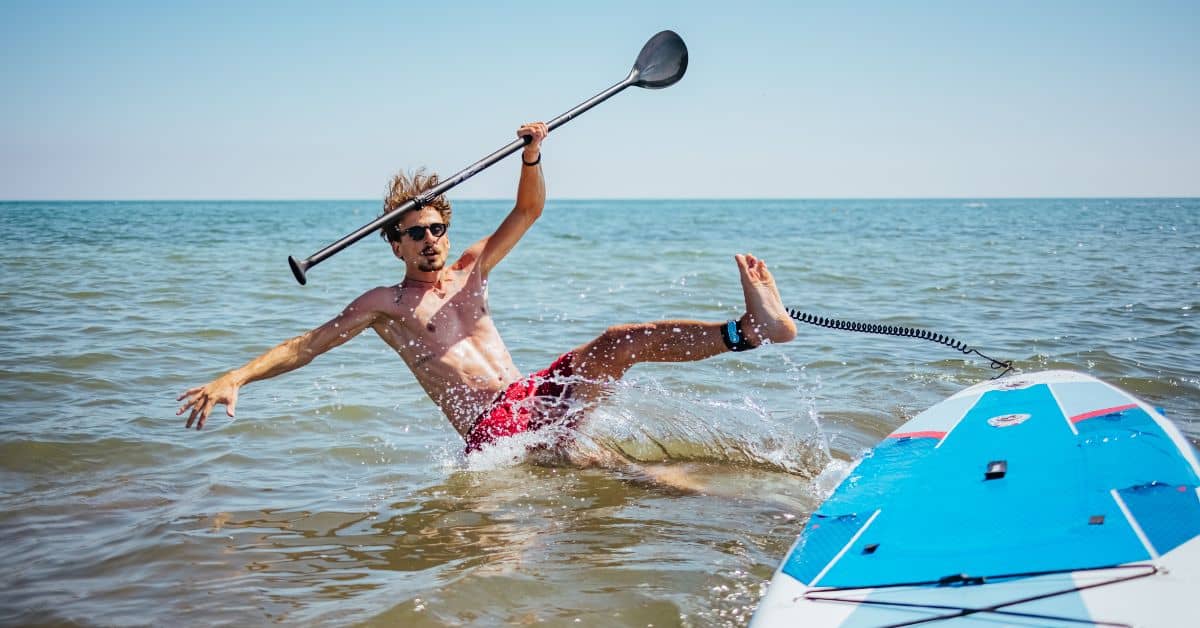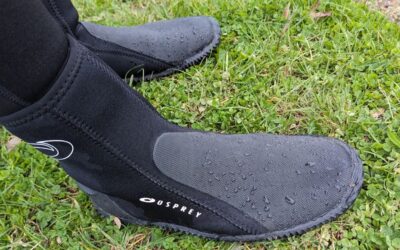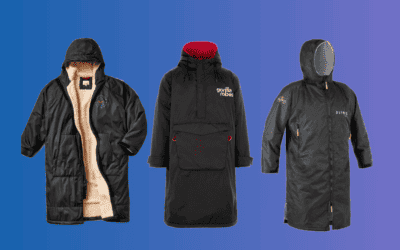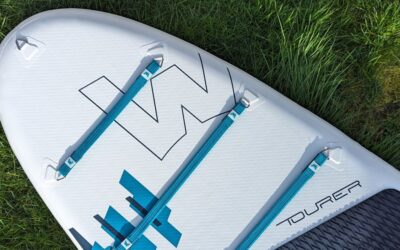Stand up paddle boarding (SUP) is a fantastic way to enjoy the water, get a full-body workout, and soak up the sun. But as a beginner, there can be a bit of a learning curve.
Here are 19 things I wish I knew when I started stand up paddle boarding.
Now let’s jump in!
Things I Wish I Knew When I Started Stand Up Paddle Board
Embarking on the journey of stand up paddle boarding is an exciting adventure filled with fun, challenges, and a whole lot of learning.
Looking back on my own SUP journey, there are several things I wish I knew when I first started.
These nuggets of wisdom would have saved me from some common beginner mistakes, helped me progress faster, and made my experience even more enjoyable.
Below I’ll share these insights with you, in hopes that they will enhance your own SUP journey, whether you’re just starting out or looking to refine your skills.
Disclaimer: If you make a purchase via the links on our site, I may earn an affiliate commission at no additional cost to you. You can read my affiliate disclosure in the privacy policy. Thanks for your support!
The Basics of Stand Up Paddle Boarding

#1 How To Choose the Right Equipment
Did you know that paddle boards come in different sizes and shapes, each designed for a specific type of water or activity?
Well, I didn’t! If I had this knowledge earlier, it would have prevented me from buying a paddle board that wasn’t the right match for me, and it would have saved me a considerable amount of money as well.
When I first started, I thought all paddle boards were the same. But oh, how wrong I was! Paddle boards come in a variety of designs, with a wide range of unique features and each tailored to different conditions and uses. Let’s break it down:
All-around boards: These are the jack-of-all-trades in the paddle board world. They’re great for beginners because they’re designed to be stable and easy to manoeuvre in a variety of conditions. They’re typically wide and long, providing a stable platform for those still finding their sea legs.
Touring boards: These are designed for long-distance paddling and racing. They’re usually longer and narrower than all-around boards, allowing them to cut through the water more efficiently. However, they can be a bit more challenging to balance on, especially for beginners.
Inflatable SUPs: Inflatable paddle boards or iSUPs, have gained immense popularity in recent years. In fact, most paddlers you’ll see on the water are likely using an inflatable SUP. Their popularity stems from their convenience and versatility. They can be deflated and packed into a backpack, making them ideal for those with limited storage or those who love to travel with their board.
It’s safe to say, modern iSUPs offer excellent performance, rivaling that of solid boards. Plus, there’s a fantastic range of cheap inflatable SUPs available on the market today, catering to all skill levels that won’t break the bank.

Some other options include surf SUPs, with their shorter, lighter, and more manoeuvrable design, which are perfect for wave riding, while yoga SUPs, with their wider build and soft top, offer stability and comfort for those looking to practice yoga on the water.
However, choosing the right board is just the start. You also need to consider the paddle. Paddles come in different lengths and materials, and the right one for you depends on your height and paddling style. A general rule of thumb is to choose a paddle that’s 6 to 8 inches taller than you.
Finally, don’t forget about the leash. A leash keeps your board attached to you if you fall off, preventing it from being swept away by the current. There are different types of leashes for different water conditions, so make sure to choose the right one.
Choosing the right equipment is crucial to your SUP experience. It can mean the difference between struggling in the water and gliding effortlessly across it. So, take the time to research and choose the right equipment for you. Trust me, it’s worth it!
#2 Try Before You Buy
As briefly mention above, I wish I had known the importance of trying before buying when choosing my first SUP, as it would have saved me a significant amount of money. By testing different boards and paddles, I could have found the ones that best suited my needs and skill level, instead of investing in equipment that wasn’t the right fit for me.
So if you have an opportunity to try out a friend’s board before you buy I would strongly recommend you take them up on the offer.
Seeking advice from experienced paddlers or professionals could have further guided my purchasing decisions. So don’t be afraid to ask questions.

#3 Check Your Equipment Before Hitting the Water
Your equipment is your lifeline when stand up paddle boarding. It’s the barrier between you and the water, and ensuring it’s in top-notch condition is crucial for a safe and enjoyable SUP experience. Here are some key points to check before you head out:
Inflated Board: If you’re using an inflatable SUP board, ensure it’s inflated to the recommended PSI levels. This might require some effort, but it’s essential for the board’s performance and stability. Remember to set the valve to the open position (usually by turning it counterclockwise) when inflating. To deflate, press the valve downward and turn clockwise. But remember, never attempt to deflate the board while you’re still on the water.
Leash: Your leash is your safety tether to your board. Make sure it’s securely attached to your ankle, with the velcro strap snugly wrapped around. Typically, you’ll want to attach the leash to the ankle of your non-dominant foot.
Paddle: Whether you have a one-piece or adjustable paddle, ensure it’s the right height for you and securely connected. An ill-fitted or loose paddle can hinder your paddling efficiency and control.
Repair Kit: While punctures are rare, they can happen with inflatable boards. Always bring a repair kit with you when paddling near rocky areas or beaches.
#4 Wear The Correct Clothing
Wearing the correct clothing is crucial for both comfort and safety. Your attire should be suitable for the weather and water conditions you’ll be paddling in.
In warm weather, opt for quick-drying, breathable clothing that protects you from the sun. A hat and sunglasses can also be beneficial.
In cooler conditions, consider wearing a wetsuit or drysuit to maintain your body temperature. Remember, even if the air is warm, the water might be cold, so dress for the water temperature.
Additionally, always wear a personal flotation device for safety. Lastly, don’t forget about your feet – water shoes can provide extra grip on the board and protect your feet when entering or exiting the water.

#5 Understanding the Water Conditions
Water conditions can make or break your SUP experience. Knowing how to read the water – the waves, the current, the wind – is crucial. It’s something I wish I had understood earlier.
Firstly, the state of the water surface, whether it’s calm, choppy, or wavy, greatly affects your balance and the board’s stability. Calm waters are ideal for beginners, while choppy waters and waves present a fun challenge for more experienced paddlers.
Secondly, the current can either be your best friend or your worst enemy. A strong current can quickly carry you away from your intended path, making it essential to understand its direction and strength.
Lastly, the wind plays a significant role. It can either aid your journey or make paddling strenuous. Knowing the wind direction and speed can help you plan your route and energy expenditure.
In essence, understanding water conditions is not just about safety; it’s about enhancing your SUP experience.
Essential Skills for Stand Up Paddle Boarding

#6 Balancing Techniques
Balancing on a paddle board isn’t as easy as it looks!
It’s a skill that takes time and practice to master. It’s not as simple as just standing on the board; it involves understanding your body’s centre of gravity and how to adjust it according to the water’s movement.
A wide stance, with your feet parallel and positioned approximately hip-width apart, provides a solid base for maintaining balance.
Your gaze plays a crucial role too. Instead of looking down at your feet or the board, keep your eyes on the horizon. This helps maintain an upright posture, which is key for balance.
Additionally, remember to keep your knees slightly bent. This acts as a shock absorber for any motion from the water, further aiding in maintaining balance. Over time, as your confidence and skill grow, you’ll find yourself becoming more comfortable and stable on your board.
#7 Paddling Techniques
Paddling efficiently is another key skill. It’s not just about strength; it’s about technique.
When paddling, it’s important to engage your core muscles, not just your arms. This provides more power and endurance, allowing you to paddle longer and more efficiently.
The basic stroke involves reaching forward with your paddle, submerging it into the water, and pulling it back towards you.
But remember, to paddle forward, the power should come from your torso’s rotation, not just your arms pulling. This technique, often overlooked by beginners, is crucial for efficient and effective paddling.
#8 Turning Techniques
Turning a paddle board can be tricky, especially in strong currents or winds. It’s not as simple as just paddling on one side.
There are specific techniques that can help you turn more effectively. The sweep stroke is one such technique. It involves a wide, sweeping paddle motion from the front of the board to the back. This motion creates a force that turns the board in the opposite direction.
The back paddle is another useful technique which involves paddling backwards on one side, which turns the board towards that side.
Both techniques require practice to execute smoothly and effectively. Understanding and mastering these turning techniques can greatly enhance your control over the board, making your SUP experience more enjoyable and safe.

#9 Falling Off Your Paddle Board
One of the most important skills in stand up paddle boarding, surprisingly, is learning how to fall. Falling off your board is inevitable, especially as a beginner, and it’s a crucial part of the learning process.
Falling helps you understand your balance points, teaches you how to get back on your board, and most importantly, it helps you overcome the fear of falling. When you accept that falling is part of the journey, you become more confident and willing to push your boundaries.
Remember, the key is not to avoid falling, but to learn how to fall safely. Always aim to fall away from your board to avoid injury, and once in the water, get back on your board as quickly as possible. With time, falling will become less frequent, but the lessons it teaches will stay with you throughout your SUP journey.

#10 Paddle On Your Knees
As a beginner, you might find balancing on the board a bit challenging at first. That’s perfectly normal, and there’s no need to rush. It’s completely okay to start paddling from your knees. This position offers more stability and can help you get comfortable with the board and the paddle.
Starting on your knees allows you to focus on your paddle strokes and get a feel for the water without worrying about balance. As you gain confidence, you can gradually start to stand up. Remember, everyone learns at their own pace, and there’s no right or wrong way to start. The most important thing is to enjoy the process and stay safe on the water.
Safety Measures in Stand Up Paddleboarding
#11 Importance of Wearing a Life Jacket
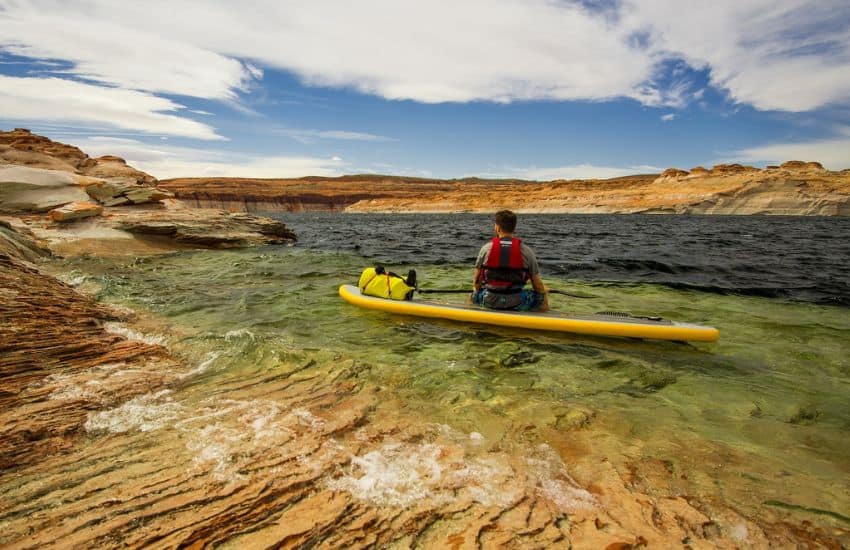
Wearing a life jacket is a non-negotiable aspect of paddle boarding safety. Even if you’re a strong swimmer, unexpected situations can arise that make a life jacket invaluable. It provides buoyancy, helping you stay afloat if you fall off your board or get caught in a current. Remember, water conditions can change rapidly, and it’s always better to be safe than sorry.
Editors Pick
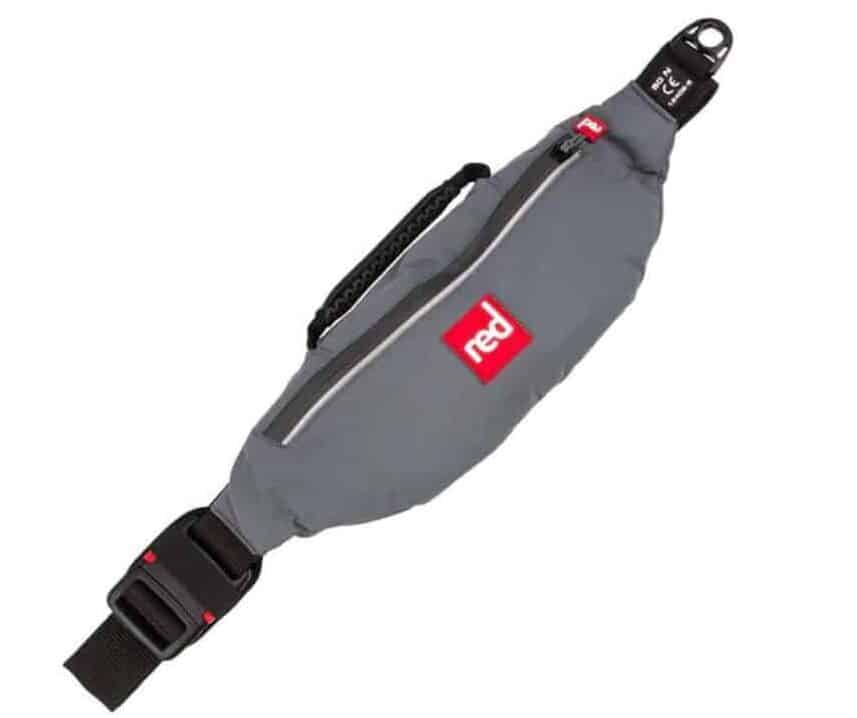
Red Original Airbelt
- Compact and lightweight inflatable PFD belt
- Phone-sized water-resistant pocket and D-clips
- 5-year warranty
#12 Understanding Weather Conditions
Before heading out on your paddle board, it’s crucial to check the weather forecast. Weather changes can drastically affect the water’s state, making it potentially dangerous. Knowing the tide times, wind direction and speed, and any potential weather changes can help you plan a safer and more enjoyable paddle boarding session.
#13 Plan For An Emergency
Safety should always be your top priority when stand up paddle boarding. Part of being prepared is having an emergency plan in place. Before you head out, make sure you’re familiar with the area and the potential hazards it may present. Know where you can safely get to shore if needed.
Always let someone know where you’re going and how long you plan to be out. Carry a whistle or other sound-producing device to signal for help if necessary. If you’re paddling in a remote area or out of sight of land, consider carrying a personal locator beacon or a waterproof phone.
In case of equipment failure, such as a puncture on an inflatable board, ensure you have a repair kit and know how to use it. And remember, always wear a personal flotation device.
Having an emergency plan gives you peace of mind and can be crucial in ensuring your safety on the water.

#14 Knowing When to Rest
Paddle boarding is a full-body workout, and like any physical activity, it’s important to know when to rest. Overexertion can lead to exhaustion, which can be dangerous, especially when you’re out on the water. Listen to your body’s signals. If you’re feeling tired, take a break. It’s not just about endurance; it’s about enjoying the experience safely.
#15 Stay Hydrated and Pack Snacks
Stand up paddle boarding is a fun but physically demanding activity. It’s important to stay hydrated and keep your energy levels up, especially during longer sessions. Always bring a water bottle with you on your SUP adventures. Many paddle boards come with bungee cords or storage areas where you can secure your water bottle.
In addition to staying hydrated, packing some snacks can be a great idea. Energy bars, fruit, or nuts can provide a quick energy boost when you need it. If you’re planning a longer trip, consider packing a small picnic to enjoy on the water or on shore.
Remember, paddle boarding is about enjoying the journey, not just the destination. Staying hydrated and well-fed will help ensure you have the energy to enjoy every moment.
Enhancing Your Stand Up Paddle Boarding Experience
#16 Invest in an Electric Pump
If you’re using an inflatable stand up paddle board, investing in an electric sup pump can be a game-changer. While manual pumps can certainly get the job done, they require a considerable amount of effort and time. An electric pump, on the other hand, makes the inflation process quick and effortless.
Simply connect the pump to the board’s valve, set the desired PSI, and let the pump do the work. This not only saves you time and energy but also ensures that your board is inflated to the optimal pressure for best performance.
Moreover, most electric pumps are compact and portable, making them easy to carry along on your paddle boarding adventures. While an electric pump might be a bit more of an investment compared to a manual one, the convenience and efficiency it offers make it well worth considering.
Best Electric Pump
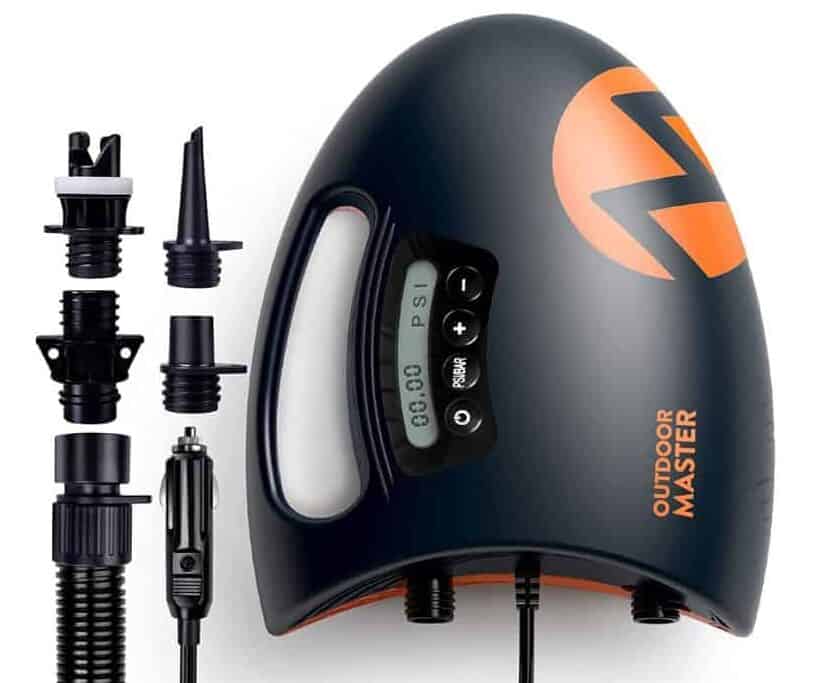
OutdoorMaster The Shark II
- Inflate multiple boards with its active cooling system
- Full set of nozzle and valve attachments
- Digital display with real-time pressure monitoring
#17 Exploring Different Locations
One of the best things about paddle boarding is the ability to explore different locations. Each location offers a unique experience, from the tranquillity of a calm lake, or the challenge of a flowing river, to the adventure of the open sea. Exploring new locations not only adds variety to your SUP experience but also helps you develop and adapt your skills to different water conditions.

Additionally, it’s important to note that in some areas, you may need a waterways license to paddle board. So, before you set out to explore, make sure to check the local regulations and obtain any necessary permits or licenses. This ensures you can enjoy your adventure while respecting local laws and protecting our waterways.
#18 Joining a Paddle Boarding Community
Being part of a paddle boarding community can significantly enrich your SUP experience. It provides a platform to learn from more experienced paddlers, share experiences, and even make new friends. Group trips and community events can add a social aspect to the sport, making it even more enjoyable.
One way to find these communities is by joining an official SUP club. These clubs often organize regular meetups, training sessions, and events, providing ample opportunities to improve your skills and meet like-minded individuals. They may also offer resources like equipment rentals or lessons for beginners.
Another great resource is social media. Platforms like Facebook have numerous local and global paddle boarding groups where members share their experiences, tips, and organize informal meetups. These groups can be a treasure trove of information, especially for beginners.
Joining a paddle boarding community can transform your SUP experience from a solitary activity into a social one, filled with learning, camaraderie, and shared adventures.

#19 Participating in Races and Events
Paddle boarding is not just a leisure activity; it can also be a competitive sport. Participating in races and events can add an exciting challenge to your SUP journey. It’s a great way to test your skills, push your limits, and meet fellow paddle boarders and enthusiasts. Plus, the thrill of competition can be a great motivator for improving your skills.
Final Thoughts
Stand up paddle boarding is a journey of learning and discovery. It’s about enjoying the water, improving your skills, and most importantly, having fun. Looking back, these are the 19 things I wish I knew when I started. But remember, every paddler’s journey is unique. So, get out there, make your own discoveries, and most importantly, enjoy every moment on the water.
Frequently Asked Questions
What is the best paddleboard for beginners?
The best paddle board for beginners is usually a wider, longer board with good stability. It allows for easier balance and control.
Do I need to wear a life jacket while paddle boarding?
Yes, wearing a PFD is highly recommended for safety reasons, regardless of your swimming abilities.
Can I paddle board in any type of water?
Paddleboarding can be done in various water types, including lakes, rivers, and the sea. However, it’s important to understand the specific conditions and challenges of each.
Is stand up paddleboarding a good workout?
Yes, stand up paddleboarding is a great full-body workout. It engages your core, arms, legs, and back muscles.
How do I improve my balance on a paddleboard?
Improving balance involves practice, maintaining a wide stance, keeping your eyes on the horizon, and engaging your core.

About the Author
Steve Cleverdon is an adventure blogger dedicated to helping outdoor enthusiasts make the most of their outdoor experiences. With years of travel and many epic adventures including a 3000-kilometre solo hike across New Zealand, Steve has amassed practical knowledge on outdoor gear. You can learn more about his adventures here. Through expert reviews, recommendations, and guides, he equips his readers with the best gear for their next adventure. If you want to send Steve a quick message, visit his contact page here.

